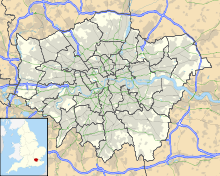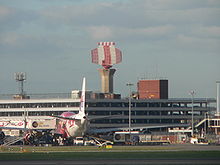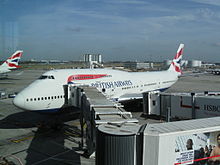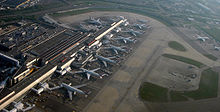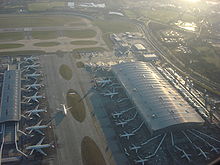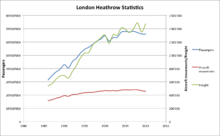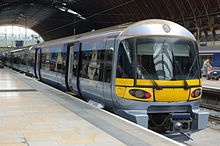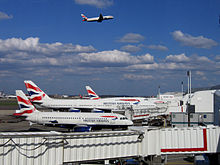- London Heathrow Airport
-
"Heathrow" and "LHR" redirect here. For other uses, see Heathrow (disambiguation) and LHR (disambiguation).
London Heathrow Airport 
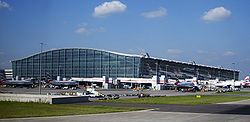
Heathrow Terminal 5 building IATA: LHR – ICAO: EGLL
– WMO: 03772Summary Airport type Public Owner BAA Limited Operator Heathrow Airport Limited Location Hillingdon, United Kingdom Hub for Elevation AMSL 83 ft / 25 m Coordinates 51°28′39″N 000°27′41″W / 51.4775°N 0.46139°WCoordinates: 51°28′39″N 000°27′41″W / 51.4775°N 0.46139°W Website Map Location within Greater London Runways Direction Length Surface m ft 09L/27R 3,901 12,799 Grooved Asphalt 09R/27L 3,660 12,008 Grooved asphalt Statistics (2010) Passengers 65,881,660 Passenger change 09-10  0.2%
0.2%Aircraft movements 454,823 Movements change 09-10  2.5%
2.5%
-
Sources: UK AIP at NATS and EUROCONTROL[1]
Statistics from the UK Civil Aviation Authority[2]London Heathrow Airport or Heathrow (IATA: LHR, ICAO: EGLL), in the London Borough of Hillingdon, is the busiest airport in the United Kingdom and the third busiest airport in the world (as of 2011) in terms of total passenger traffic, handling more international passengers than any other airport around the globe.[3] It is also the busiest airport in the EU by passenger traffic and the third busiest in Europe given the number of traffic movements, with a figure surpassed only by Paris-Charles de Gaulle Airport and Frankfurt Airport.[4] Heathrow is London's main airport, having replaced RAF Northolt, and together with Gatwick, Stansted, Luton and London City, more than 175 million passengers have travelled in total, making London by far the busiest city airport system in the world.
The airport is owned and operated by BAA Limited, who also own and operate five other UK airports.[5] BAA is owned by ADI Limited, an international consortium led by the Spanish Ferrovial Group, which also includes Caisse de dépôt et placement du Québec and GIC Special Investments.[6] Heathrow is a primary hub for BMI and British Airways as well as a base for Virgin Atlantic Airways.
Heathrow lies 12 nautical miles (22 km; 14 mi) west[1] of Central London, and has two parallel east–west runways along with four operational terminals on a site that covers 12.14 square kilometres (4.69 sq mi). Terminal 5 was officially dedicated by Queen Elizabeth II on 14 March 2008 and opened to passengers on 27 March 2008. Construction of a new Terminal 2 complex to replace the old terminal building and adjacent Queen's Building began in 2009 with the first phase expected to open in 2014.[7] Terminals 3 and 4 underwent major refurbishments between 2007–2009. In November 2007, a consultation process began for the building of a new third runway and a sixth terminal, which was controversially[8] approved on 15 January 2009 by UK Government ministers.[9] The project was subsequently cancelled on 12 May 2010 by the Cameron Government.[10]
The airport holds a Civil Aviation Authority Public Use Aerodrome Licence (Number P527), which allows flights for public transportation of passengers or for flying instruction.[11]
Contents
Location
 A Qantas Boeing 747-400 on approach to London Heathrow 27L runway overflying the roofs of houses in Myrtle Avenue.
A Qantas Boeing 747-400 on approach to London Heathrow 27L runway overflying the roofs of houses in Myrtle Avenue.
Heathrow is 12 nmi (22 km; 14 mi) west of central London,[1] near the south end of the London Borough of Hillingdon on a parcel of land that is designated part of the Metropolitan Green Belt. The airport is surrounded by the built-up areas of Harlington, Harmondsworth, Longford and Cranford to the north and by Hounslow and Hatton to the east. To the south lie East Bedfont and Stanwell while to the west Heathrow is separated from Colnbrook in Berkshire by the M25 motorway.
As the airport is west of London and as its runways run east–west, an airliner's landing approach is usually directly over the city of London. Other leading European airports, such as those at Madrid, Frankfurt and Paris, are located north or south of their respective cities to minimise the overflying problem.[citation needed]
Along with Biggin Hill, Gatwick, Stansted, Luton, Southend and City, Heathrow is one of seven airports serving the London area although only Heathrow, Biggin Hill and City are located within Greater London.
History
- For a chronicled history of Heathrow Airport, see History of London Heathrow Airport.
Heathrow Airport started in 1929 as a small airfield on land southeast of the hamlet of Heathrow (which is roughly where Terminal 3 is today). It was then selected for development as an aerodrome in 1944 for long-distance military aircraft bound for the far east. But by the time the aerodrome was nearing completion, World War 2 had ended. The government decided to once again develop the site, but this time as a civil airport, known as London Airport and later Heathrow.
Heathrow today
Heathrow Airport is used by over 90 airlines flying to 170 destinations worldwide. The airport is the primary hub of BMI and British Airways, and is a base for Virgin Atlantic Airways.
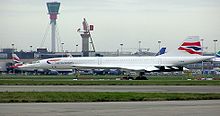 Concorde G-BOAB in storage at Heathrow
Concorde G-BOAB in storage at Heathrow
Of Heathrow's 67 million annual passengers, 11% are bound for UK destinations, 43% are short-haul international travellers and 46% are long-haul. The busiest single destination in terms of passenger numbers is New York, with over 3.7 million passengers travelling between Heathrow and JFK / Newark airports in 2008[12] and 3.5 million in 2009.[13] The airport has five passenger terminals (Terminals 1, 2, 3, 4 and 5) and a cargo terminal.
In the 1950s, Heathrow had six runways, arranged in three pairs at different angles in ✡ shape, with the permanent passenger terminal in the centre and the older terminal along the north edge of the field, and two of its runways would always be within 30° of the wind direction. As the required length for runways has grown, Heathrow now has just two parallel runways running east–west.
Policing of the airport is the responsibility of the aviation security unit of the Metropolitan Police, although the army, including armoured vehicles of the Household Cavalry, has occasionally been deployed at the airport during periods of heightened security. Heathrow's reputation for thefts has led to it sometimes being referred to as 'Thiefrow'.[14]
Full body scanners are now used at the airport and passengers who object to their use are not allowed to fly.[15]
Heathrow Airport has Anglican, Catholic, Free Church of Scotland, Hindu, Jewish, Muslim and Sikh chaplains. There is a multi-faith prayer room and counselling room in each terminal in addition to St. George's Interdenominational Chapel located in an underground bunker adjacent to the old control tower, where Christian services take place. The chaplains organise and lead prayers at certain times in the prayer room.[16]
Heathrow airport has its own resident press corps, consisting of six photographers and one TV crew, serving all the major newspapers and television stations around the world.[17]
Operations
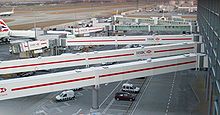 Airbridges at Terminal 5
Airbridges at Terminal 5
Aircraft destined for Heathrow usually enter its airspace via one of four main reporting points: Bovingdon (BNN) over Hertfordshire, Lambourne (LAM) over Essex, Biggin Hill (BIG) over Bromley and Ockham (OCK) over Surrey.[18] Each is defined by a VOR radio-navigational beacon. When the airport is busy, aircraft orbit in the associated hold patterns. These reporting points/holds lie to the north-west, north-east, south-east and south-west of the London conurbation.
Air traffic controllers at Heathrow Approach Control (based in Swanwick, Hampshire) then guide the aircraft to their final approach, merging aircraft from the four holds into a single stream of traffic, sometimes as close as 2.5 nautical miles (4.6 km; 2.9 mi) apart. Considerable use is made of continuous descent approach techniques to minimise the environmental effects of incoming aircraft, particularly at night.[19] Once an aircraft is established on its final approach, control is handed over to Heathrow Tower.
Because aircraft generate significantly more noise on departure than when landing, there is a preference for westerly operations during daylight.[20] In this mode, aircraft depart towards the west and approach from the east over London, thereby minimising the impact of noise on the most densely populated areas. Heathrow's two runways generally operate in segregated mode, whereby arriving aircraft are allocated to one runway and departing aircraft to the other. To further reduce noise nuisance to people beneath the approach and departure routes, the use of runways 27R and 27L is swapped at 15:00 each day if the wind is from the west. When easterly landings are in progress there is no alternation; 09L remains the landing runway and 09R the departure runway due to the Cranford Agreement. Occasionally, landings are allowed on the nominated departure runway, to help reduce airborne delays and to position landing aircraft closer to their terminal, thus reducing taxi times.
Night-time flights at Heathrow are subject to restrictions. Between 23:00 and 07:00, the noisiest aircraft (rated QC/8 and QC/16) cannot be scheduled for operation. In addition, during the night quota period (23:30–06:00) there are three limits:
- A limit on the number of flights allowed;
- A quota count system which limits the total amount of noise permitted, but allows operators to choose to operate fewer noisy aircraft or a greater number of quieter planes;[21]
- A voluntary ban on QC/4 aircraft.
Regulation
Further information: Landing slotAs BAA own Heathrow and Stansted, two of London's major airports (respectively the first and third busiest by passengers in London), they hold a dominiant position in the London Aviation market and are heavily regulated by the Civil Aviation Authority (CAA) as to the amounts they charge airlines to land at Heathrow. Until 1 April 2003, the annual increase in landing charge per passenger was capped at inflation minus 3%. From 2003 to 2007, charges increased by inflation plus 6.5% per year, taking the fee to £9.28 per passenger in 2007. In March 2008, the CAA announced that the charge would be allowed to increase by 23.5% to £12.80 from 1 April 2008, and by inflation plus 7.5% for each of the following four years.[22]
Prior to 2008, Air traffic between Heathrow and the United States was strictly governed by the countries' bilateral Bermuda II treaty. The treaty originally allowed only British Airways, Pan Am and TWA to fly from Heathrow to the US. In 1991, PAA and TWA sold their rights to United Airlines and American Airlines respectively while Virgin Atlantic was added to the list of airlines allowed to operate on these routes. The Bermuda bilateral agreement conflicted with the Right of Establishment of the United Kingdom in terms of its EU membership, and as a consequence the UK was ordered to drop the agreement in 2004. A new "open skies" agreement was signed by the United States and the European Union on 30 April 2007 and came into effect on 30 March 2008. Since then, additional US Airlines including Continental, US Airways and Delta have started services to Heathrow.
Whilst the cost of landing at Heathrow is determined by the CAA and BAA, the allocation of landing slots to airlines is carried out by Airport Co-ordination Limited (ACL).[23]
According to BAA, Heathrow's facilities were originally designed to accommodate 55 million passengers annually. With this number currently approaching 70 million, the airport has been criticised in recent years for its overcrowding and delays,[24] and in 2007 the airport was voted the world's least favourite alongside Chicago O'Hare in a TripAdvisor survey.[25] However, the opening of Terminal 5 in 2008 has relieved some pressure on terminal facilities, increasing the airport's terminal capacity to 90 million passengers a year.
With only two runways operating at over 98% of their capacity, Heathrow has little room for more flights, although the increasing use of larger aircraft such as the Airbus A380 will allow some increase in passenger numbers. It is difficult for existing airlines to obtain landing slots to enable them to increase their services from the airport, or for new airlines to start operations.[26] In order to increase the number of flights, BAA have proposed using the existing two runways in 'mixed mode' whereby aircraft would be allowed to take-off and land on the same runway.[27] This would increase the airport's capacity from its current 480,000 movements per year to as many as 550,000 according to British Airways CEO Willie Walsh.[28] BAA also proposed building a third runway to the north of the airport, which would have significantly increased traffic capacity (see Future expansion below).[29]
Terminals, airlines and destinations
Terminals
Terminal 1
Main article: London Heathrow Terminal 1Terminal 1 opened in 1968 and was formally inaugurated by Queen Elizabeth II in May 1969.[30] Before Terminal 5 opened, Terminal 1 was the base for British Airways' domestic network from Heathrow and for a few of its long haul routes.
In 2005, substantial redesign and redevelopment of the terminal saw the opening of the new Eastern Extension, doubling the size of the departure lounge and creating additional seating as well as retail space. With an area of 74,601m2, the terminal is home to Heathrow's second largest carrier, Star Alliance member BMI, Aer Lingus, and several other Star Alliance airlines. Some of the newer airplane boarding gates used by airlines present in Terminal 1 are numbered in Terminal 2 (i.e. gate 2xx instead of gate 1xx). Those recently built gates will be retained as part of the new Terminal 2 after Terminal 2 officially opens. A temporary connector is in place between the (older) Terminal 1 and these (recently built) airplane gates.
Terminal 1 will be closed and then demolished in around 2013–14,[7] in preparation for construction of the 2nd phase of Terminal 2, scheduled for completion in 2019. There are no plans to re-use the Terminal 1 name.
Terminal 2 (under construction)
Main article: London Heathrow Terminal 2Heathrow's current major project is the construction of a vast new Terminal 2. Formerly known as Heathrow East Terminal, the whole project will occupy a site similar in size to that of Terminal 5.
Old Terminal 2
The building previously known as Terminal 2 had been Heathrow's oldest terminal, opening as the Europa Building in 1955, and closing on 23 November 2009.[31] Air France flight AF1881 to Paris was the last flight to depart from the terminal. It had an area of 49,654m2 and in its lifetime saw 316 million passengers pass through its doors. Originally designed to handle around 1.2 million passengers annually, in its final years of operation it often accommodated around 8 million. Despite the best efforts of maintenance staff and various renovations and upgrades over the years, the building became increasingly decrepit and unserviceable and was demolished in the Summer of 2010.[32] The resulting space has been combined with an adjacent area (where the Queen's Building stood until its demolition in 2009) to form the site for the new terminal.
Terminal 3
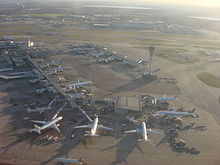 Terminal 3 bird's-eye view
Terminal 3 bird's-eye view
Terminal 3 opened as The Oceanic Terminal on 13 November 1961 to handle flight departures for long-haul routes.[33] At this time the airport had a direct helicopter service to Central London from the gardens on the roof of the terminal building. Renamed Terminal 3 in 1968, it was expanded in 1970 with the addition of an arrivals building. Other facilities added included the UK's first moving walkways. In 2006, the new £105 million Pier 6 was completed[34] in order to accommodate the Airbus A380 superjumbo; Singapore Airlines, Emirates and Qantas now operate regular flights from Terminal 3 using the Airbus A380. Terminal 3 has an area of 98,962m2. Redevelopment of Terminal 3's forecourt through the addition of a new four lane drop-off area and a large pedestrianised plaza, complete with canopy to the front of the terminal building, was completed in 2007. These improvements were intended to improve passengers' experiences, reduce traffic congestion and improve security. As part of this project, Virgin Atlantic were assigned their own dedicated check-in area, known as 'Zone A', which features a large sculpture and atrium. BAA also has plans for a £1bn upgrade of the rest of the terminal over the next ten years which will include the renovation of aircraft piers and the arrivals forecourt. A new baggage system connecting to Terminal 5 (for British Airways connections) is currently under construction. In addition to the baggage system, the baggage claim hall is also set to undergo changes with dedicated A380 belts and an improved design and layout.[35]
Terminal 4
Main article: London Heathrow Terminal 4First opened in 1986, Terminal 4 is situated to the south of the southern runway next to the cargo terminal, and is connected to Terminals 1, 2 and 3 by the Heathrow Cargo Tunnel. The terminal has an area of 105,481m2 and is now home to the SkyTeam alliance as well as some unaffiliated carriers. It has recently undergone a £200m upgrade to enable it to accommodate 45 airlines with an upgraded forecourt to reduce traffic congestion and improve security. An extended check-in area with renovated piers and departure lounges as well as two new stands to accommodate the Airbus A380 have been constructed, and a new baggage system installed.[36]
Terminal 5
Main article: London Heathrow Terminal 5Terminal 5 lies between the northern and southern runways at the west end of the Heathrow site, and was opened by Queen Elizabeth II on 14 March 2008,[37] some 19 years after its inception. Opened to the public on 27 March 2008, the first passenger to enter Terminal 5 was a UK ex-pat from Kenya who passed through security at 04:30 on the day to be presented with a boarding pass by the British Airways CEO Willie Walsh for the first departing flight, BA302 to Paris. During the two weeks after its opening, operations were disrupted by problems with the terminal's IT systems, coupled with insufficient testing and staff training, which caused over 500 flights to be cancelled.[38] Terminal 5 is exclusively used by British Airways as their global hub.
Built at a cost of £4.3 billion, the new terminal consists of a four storey main terminal building (Concourse A) and two satellite buildings linked to the main terminal by an underground people mover transit system. The second satellite (Concourse C), includes dedicated aircraft stands for the Airbus A380. It became fully operational on 1 June 2011.
The main terminal building (Concourse A) has an area of 300,000 square metres (3,200,000 sq ft) while Concourse B covers 60,000 square metres (650,000 sq ft).[39] It has 60 aircraft stands and capacity for 30 million passengers annually as well as more than 100 shops and restaurants.[40]
A further building, designated Concourse D and of similar size to Concourse C, may yet be built to the East of the existing site, providing up to another 16 stands. Following British Airways' merger with Iberia, this may become a priority since the newly combined business will require accommodation at Heathrow under one roof in order to maximise the cost savings envisaged under the deal. A proposal for Concourse D featured in Heathrow's most recent capital investment plan.
The transport network around the airport has been extended to cope with the increase in passenger numbers. A dedicated motorway spur links the M25 between junctions 14 and 15 to the terminal, which includes a 3,800 space multi-storey car park. A more distant long-stay car park for business passengers will be connected to the terminal by a personal rapid transit system, which will become operational in Spring 2011.[41] New branches of both the Heathrow Express and the Underground's Piccadilly Line serve a new shared Heathrow Terminal 5 station.
Airlines and destinations
Airlines Destinations Terminal Aegean Airlines Athens, Larnaca 1 Aer Lingus Belfast-International, Cork, Dublin, Shannon 1 Aeroflot Moscow-Sheremetyevo 4 Air Algérie Algiers 4 Air Astana Almaty 4 Air Canada Calgary, Edmonton, Halifax, Montréal-Trudeau, Ottawa, Toronto-Pearson, Vancouver
Seasonal: St. John's3 Air China Beijing-Capital 3 Air France Paris-Charles de Gaulle 4 Air India Delhi, Mumbai 4 Air Malta Malta 4 Air Mauritius Mauritius 4 Air New Zealand Auckland, Hong Kong, Los Angeles 1 Air Seychelles Mahé [ends 8 January] 4 Air Transat Seasonal: Toronto-Pearson 4 Alitalia Milan-Linate, Rome-Fiumicino 4 Alitalia operated by Air One Rome-Fiumicino 4 All Nippon Airways Tokyo-Narita 3 American Airlines Boston, Chicago-O'Hare, Dallas/Fort Worth, Los Angeles, Miami, New York-JFK, Raleigh/Durham 3 Arik Air Lagos 4 Asiana Airlines Seoul-Incheon 1 Austrian Airlines Vienna 1 Austrian Airlines operated by Tyrolean Airways Vienna 1 Azerbaijan Airlines Baku 4 Biman Bangladesh Airlines Dhaka, Dubai, Manchester 4 BMI Addis Ababa, Agadir, Almaty, Amman-Queen Alia, Amritsar, Baku, Basel/Mulhouse, Beirut, Belfast-City, Berlin-Brandenburg [begins 3 June 2012], Berlin-Tegel [ends 2 June 2012], Bishkek, Cairo, Casablanca, Damascus, Dammam, Dublin, Edinburgh, Freetown, Jeddah, Khartoum, Manchester, Marrakech, Moscow-Domodedovo, Nice, Riyadh, Tbilisi, Tehran-Imam Khomeini, Tripoli [resumes 26 December], Vienna, Yerevan 1 BMI operated by BMI Regional Aberdeen, Bergen, Edinburgh, Hanover, Manchester, Stavanger 1 British Airways Bangkok-Suvarnabhumi, Bucharest-Otopeni, Budapest, Gibraltar, Helsinki, Larnaca, Lisbon, Prague, Singapore, Sydney, Vienna, Warsaw 3 British Airways Aberdeen, Abu Dhabi, Abuja, Accra, Algiers [ends 24 March 2012], Amsterdam, Athens, Atlanta, Bahrain, Baltimore, Bangalore, Barcelona, Basel/Mulhouse, Beijing-Capital, Berlin-Tegel, Bologna [begins 29 April 2012], Boston, Brussels, Buenos Aires-Ezeiza, Cairo, Calgary, Cape Town, Chennai, Chicago-O'Hare, Copenhagen, Dallas/Fort Worth, Dar es Salaam, Delhi, Denver, Doha, Dubai, Düsseldorf, Edinburgh, Entebbe, Frankfurt, Geneva, Glasgow-International, Gothenburg-Landvetter, Grand Cayman, Hamburg, Helsinki, Hong Kong, Houston-Intercontinental, Hyderabad, Istanbul-Atatürk, Jeddah, Johannesburg, Kiev-Boryspil, Kuwait, Lagos, Las Vegas, Los Angeles, Luanda, Lusaka, Luxembourg, Lyon, Madrid, Manchester, Mexico City, Miami, Milan-Linate, Milan-Malpensa, Montréal-Trudeau, Moscow-Domodedovo, Mumbai, Munich, Muscat, Nairobi, Nassau, New York-JFK, Newark, Newcastle upon Tyne, Nice, Oslo-Gardermoen, Paris-Charles de Gaulle, Paris-Orly, Philadelphia, Phoenix, Pisa, Providenciales, Rio de Janeiro-Galeão, Riyadh, Rome-Fiumicino, St Petersburg, San Diego, San Francisco, São Paulo-Guarulhos, Seattle/Tacoma, Shanghai-Pudong, Sofia, Stockholm-Arlanda, Stuttgart, Tel Aviv-Ben Gurion, Tokyo-Haneda, Tokyo-Narita, Toronto-Pearson, Toulouse, Vancouver, Venice, Washington-Dulles, Zürich 5 Brussels Airlines Brussels 1 Bulgaria Air Sofia 4 Cathay Pacific Hong Kong 3 China Airlines Taipei-Taoyuan 4 China Eastern Airlines Shanghai-Pudong 4 Continental Airlines Houston-Intercontinental, Newark 4 Croatia Airlines Zagreb
Seasonal: Rijeka, Split1 Cyprus Airways Larnaca 1 Delta Air Lines Atlanta, Boston, Detroit, Miami, Minneapolis/St. Paul, New York-JFK 4 EgyptAir Cairo, Luxor, Sharm el-Sheikh 3 El Al Tel Aviv 1 Emirates Dubai 3 Ethiopian Airlines Addis Ababa 3 Etihad Airways Abu Dhabi 4 EVA Air Bangkok-Suvarnabhumi, Taipei-Taoyuan 3 Finnair Helsinki 3 Gulf Air Bahrain 4 Iberia Madrid 3 Icelandair Reykjavik-Keflavík 1 Iran Air Tehran-Imam Khomeini 3 Japan Airlines Tokyo-Narita 3 Jat Airways Belgrade 4 Jet Airways Delhi, Mumbai 4 Kenya Airways Nairobi 4 Kingfisher Airlines Delhi, Mumbai 4 KLM Amsterdam 4 KLM operated by KLM Cityhopper Amsterdam 4 Korean Air Seoul-Incheon 4 Kuwait Airways Kuwait, New York-JFK 4 Libyan Arab Airlines Tripoli 4 LOT Polish Airlines Warsaw 1 Lufthansa Cologne/Bonn [resumes 25 March 2012], Düsseldorf, Frankfurt, Hamburg, Munich 1 Lufthansa operated by BMI Cologne/Bonn [ends 25 March 2012] 1 Lufthansa Regional operated by Contact Air Stuttgart 1 Malaysia Airlines Kuala Lumpur 4 Middle East Airlines Beirut 3 Oman Air Muscat 3 Pakistan International Airlines Islamabad, Karachi, Lahore, Peshawar, Sialkot 3 Qantas Bangkok-Suvarnabhumi [ends 25 March 2012][42], Hong Kong [ends 25 March 2012][42], Melbourne, Singapore, Sydney 3 Qatar Airways Doha 4 Royal Air Maroc Casablanca, Tangier 4 Royal Brunei Airlines Bandar Seri Begawan, Dubai 4 Royal Jordanian Amman-Queen Alia 3 Saudi Arabian Airlines Dammam, Jeddah, Riyadh 4 Scandinavian Airlines Copenhagen, Gothenburg-Landvetter, Oslo-Gardermoen, Stavanger, Stockholm-Arlanda 3 Singapore Airlines Singapore 3 South African Airways Cape Town, Johannesburg 1 SriLankan Airlines Colombo, Malé, Zürich [resumes 23 December] [43] 4 Swiss International Air Lines Geneva, Zürich 1 Syrian Air Damascus 4 TAM Airlines Rio de Janeiro-Galeão, São Paulo-Guarulhos 1 TAP Portugal Lisbon, Funchal 1 TAROM Bucharest-Otopeni 4 Thai Airways International Bangkok-Suvarnabhumi 3 Transaero Moscow-Domodedovo 1 Tunisair Tunis 4 Turkish Airlines Istanbul-Atatürk 3 Turkmenistan Airlines Ashgabat 3 United Airlines Chicago-O'Hare, Los Angeles, San Francisco, Washington-Dulles 1 US Airways Philadelphia 1 Uzbekistan Airlines Tashkent 1 Virgin Atlantic Airways Accra, Boston, Delhi, Dubai, Hong Kong, Johannesburg, Lagos, Los Angeles, Miami, Nairobi, New York-JFK, Newark, San Francisco, Shanghai-Pudong, Sydney, Tokyo-Narita, Washington-Dulles
Seasonal: Cape Town, Chicago-O'Hare, Vancouver [begins 24 May 2012][44]3 Vueling Airlines A Coruña, Bilbao, Vigo 3 Terminal rearrangements
Following the opening of Terminal 5 in March 2008, a hugely complex programme of terminal moves has been implemented. This has seen many airlines move so as to be grouped in terminals by airline alliance as far as possible[45]:
- Terminal 1: Star Alliance – plus a few non-aligned airlines
- Terminal 3: Oneworld – plus Virgin Atlantic and several other non-aligned airlines as well as Star Alliance members not based in Terminal 1[46]
- Terminal 4: SkyTeam – and all other non-aligned airlines
- Terminal 5: British Airways
Further moves are dependent on the airport's significant construction schedule but will broadly be as follows:
- In January 2014:
- All Star Alliance airlines will move into Phase 1 of the new Terminal 2
- Terminal 1 will be gradually demolished to make way for Phase 2 of the new Terminal 2
- In early 2019:
- Phase 2 of the new Terminal 2 will open, enabling further moves to relieve pressure on Terminal 3
Cargo
Airlines Destinations British Airways World Cargo Abu Dhabi, Amman-Queen Alia, Amsterdam, Bangkok-Suvarnabhumi, Beijing-Capital, Brussels, Budapest, Cairo, Chennai, Chicago-O'Hare, Dallas/Fort Worth, Delhi, Dubai, Frankfurt, Glasgow-Prestwick, Hong Kong, Johannesburg, Manchester, Mexico City, Milan-Malpensa, Moscow-Sheremetyevo, Mumbai, Paris-Charles de Gaulle, São Paulo-Guarulhos, Seoul-Incheon, Singapore, Sofia, Sydney, Taipei-Taoyuan, Toronto-Pearson Cathay Pacific Cargo Frankfurt, Glasgow-Prestwick, Hong Kong, Milan-Malpensa DHL Amsterdam, Brussels, East Midlands, Frankfurt, Madrid, Paris-Charles de Gaulle. Plus several other destinations Etihad Crystal Cargo Abu Dhabi, Frankfurt EVA Air Cargo Bangkok-Suvarnabhumi, Dubai, Taipei-Taoyuan Fedex Express Indianapolis, Memphis, Newark Korean Air Cargo Seoul-Incheon MASkargo Kuala Lumpur Royal Air Maroc Cargo Casablanca Royal Jordanian Cargo Amman-Queen Alia Singapore Airlines Cargo Brussels, Singapore Other facilities
 Compass Centre, when it was a British Airways facility
Compass Centre, when it was a British Airways facility
The head office of BAA Limited is located in the Compass Centre by Heathrow's northern runway,[47] a building that previously served as a British Airways flight crew centre.[48] The World Business Centre Heathrow consists of buildings one and two. 1 World Business Centre houses offices of BAA Limited, Heathrow Airport, and Scandinavian Airlines.[49] International Airlines Group has its head office in 2 World Business Centre.[50][51]
At one time, the British Airways head office, was located within Heathrow Airport at Speedbird House[52] before the completion of Waterside, the current BA head office in Harmondsworth, in June 1998.[53]
Traffic and statistics
Although BAA claims that Heathrow is the "world's busiest international airport",[54] in 2010 it ranked fourth-busiest by total passenger traffic, after Atlanta, Beijing and Chicago O'Hare which are all international airports. However, Heathrow does have the highest number of international passengers.
In 2010, Heathrow was the busiest airport in Europe in terms of total passenger traffic,[2] with 13.2% more passengers than Paris-Charles de Gaulle Airport[55] and 24.3% more than Frankfurt Airport,[56] However, it was in second place behind Charles de Gaulle in terms of total aircraft movements in 2009 with 11.2% fewer landings and take offs than its French counterpart.[57] Heathrow was the third busiest European airport by cargo traffic in 2009, after Paris Charles de Gaulle and Frankfurt.[58]
Busiest international routes at Heathrow (2010)[59] Rank Airport Passengers handled % Change
2009 / 101  New York City – JFK
New York City – JFK2,517,896  2
22  Dubai
Dubai1,787,561  3
33  Dublin
Dublin1,493,613  8
84  Hong Kong
Hong Kong1,386,779  9
95  Amsterdam
Amsterdam1,333,124  12
126  Paris – CDG
Paris – CDG1,299,701  3
37  Frankfurt am Main
Frankfurt am Main1,266,240  5
58  Los Angeles
Los Angeles1,189,309  4
49  Chicago – O'Hare
Chicago – O'Hare1,138,012  7
710  Madrid
Madrid1,093,538  3
311  Newark
Newark1,091,818  9
912  Rome – Fiumicino
Rome – Fiumicino1,032,872  9
913  Singapore
Singapore1,022,220  9
914  Munich
Munich975,465  7
715  Mumbai
Mumbai957,439  11
1116  Toronto – Pearson
Toronto – Pearson940,448  7
717  Washington – Dulles
Washington – Dulles920,514  9
918  Stockholm – Arlanda
Stockholm – Arlanda912,362  2
219  Istanbul – Atatürk
Istanbul – Atatürk905,002  11
1120  Delhi
Delhi893,196  21
2121  Johannesburg
Johannesburg886,146  4
422  Zurich
Zurich876,385  1
123  Copenhagen
Copenhagen870,072  2
224  Boston
Boston866,719  2
225  San Francisco
San Francisco860,617  4
426  Geneva
Geneva859,143  42
4227  Miami
Miami822,315  3
328  Athens
Athens784,308  18
1829  Vienna
Vienna731,100  13
1330  Lisbon
Lisbon727,335  4
431  Sydney
Sydney696,301  6
632  Tokyo – Narita
Tokyo – Narita683,186  9
933  Milan – Linate
Milan – Linate647,636  16
1634  Doha
Doha640,528  10
1035  Barcelona
Barcelona605,989  16
1636  Bangkok – Suvarnabhumi
Bangkok – Suvarnabhumi597,826  0.5
0.537  Berlin – Tegel
Berlin – Tegel596,543  16
1638  Oslo
Oslo592,477  3
339  Helsinki
Helsinki578,543  3
340  Houston – Intercontinental
Houston – Intercontinental541,632  1
1Countries with maximum passengers to/from Heathrow (2010)[60] Rank Country/Region Passengers handled % Change
2009 / 101  United States
United States12,340,933  0.03
0.032  Germany
Germany4,341,214  7.57
7.573  Italy
Italy2,377,026  12.00
12.004  Canada
Canada2,354,965  4.07
4.075  United Arab Emirates
United Arab Emirates2,291,338  0.91
0.916  India
India2,283,731  3.22
3.227  Republic of Ireland
Republic of Ireland2,156,503  3.77
3.778  France
France2,138,519  1.81
1.819  Spain
Spain2,127,872  5.24
5.2410  Switzerland
Switzerland1,896,859  14.47
14.4711  Hong Kong
Hong Kong1,386,779  9.29
9.2912  South Africa
South Africa1,378,268  6.95
6.9513  Netherlands
Netherlands1,333,124  11.70
11.7014  Sweden
Sweden1,058,134  2.01
2.0115  Turkey
Turkey1,046,910  7.86
7.8616  Australia
Australia1,030,619  1.34
1.3417  Singapore
Singapore1,022,220  9.01
9.0118  Denmark
Denmark870,104  1.90
1.9019  Russia
Russia747,425  13.93
13.9320  Portugal
Portugal746,946  2.78
2.78Access
Public transport
Train
Heathrow area rail services 




Crossrail 

London Paddington station 











Heathrow Connect Heathrow Express 




Central and District
lines




Ealing Broadway 






West Ealing 





Hanwell 




Southall 



Hayes and Harlington 




Airport Junction 



Great Western Main Line ▼Slough and Reading 




Piccadilly Line 




Hatton Cross 





 Heathrow Airport
Heathrow Airport

Central & Terminals 1,2,3 





Terminal 4 Shuttle 




Terminal 4 






Terminal 5 Heathrow Express 

- Heathrow Express: a non-stop service directly to London's Paddington station; trains leave every 15 minutes for the 15-minute journey (21 minutes to/from Terminal 5). Trains depart from Heathrow Terminal 5 station or Heathrow Central station (Terminals 1 & 3). A Heathrow Express transfer service operates between Terminal 4 and Heathrow Central to connect with services from London and Terminal 5.
- Heathrow Connect: a stopping service to Paddington calling at up to five National Rail stations en route – trains leave every 30 minutes for the 27-minute journey. Heathrow Connect services terminate at Heathrow Central station (Terminals 1 & 3).
- London Underground Piccadilly line: four tube stations serve the airport – Terminals 1, 2, 3; Terminal 4; Terminal 5 serves the passenger terminals, and Hatton Cross the maintenance areas. The standard journey time from Heathrow Terminals 1 & 3 tube station to Central London is around 40–50 minutes.[61]
Bus and coach
Many buses and coaches operate from the large Heathrow airport central bus station serving Terminals 1 and 3, and also from bus stations at Terminals 4 and 5. Services include the following:
- Long-distance coach services operated by National Express and Oxford Bus Company to various parts of the UK, including Victoria Coach Station in London[62]
- HotelHoppa buses connect each terminal with hotels in the Heathrow area[63]
- There are two RailAir coach services connecting nearby railway stations with the airport using dedicated non-stop coaches and running to:
- Reading railway station, connecting with railway services to the West Country, South Wales, Midlands and the south coast of England
- Woking railway station, for destinations in Surrey, Hampshire, Dorset and Wiltshire
- A connection to Feltham railway station, for Richmond, Camberley, Bracknell, London Waterloo and Clapham Junction, using London Buses route 285 (route 490 from Terminals 4 and 5)[64]
- Express bus services to Watford, St Albans and Harlow (Green Line route 724), Croydon (London Buses route X26) and High Wycombe (Carousel Buses)
- Local bus services by London Buses, First Berkshire & The Thames Valley and other companies to nearby towns and London suburbs[65]
- Night bus N9 operates to central London at night when the trains do not operate
Between 1981 and 2004, the airport was linked to central London by a group of routes known as Airbus. These routes carried A prefixes before their numbers; one route, A10, operates with such a number to Uxbridge.
Inter-terminal transport
Terminals 1 and 3 are within walking distance of each other. Transfers to Terminal 4 & 5 are by Heathrow Express trains or bus. Heathrow Express and Heathrow Connect services between Heathrow Central and Terminals 4 and 5 are free of charge.[66] Normal fare rules apply to London Underground services between terminals. Local buses throughout the airport area are provided free of charge under the "Heathrow FreeFlow" scheme;[67] passengers should tell the driver their destination to ensure they are not charged a fare.
Transit passengers remaining airside are provided free dedicated transfer buses between terminals.
ULTra Personal Rapid Transport has been opened in April 2011 to shuttle passengers to and from Terminal 5 at a speed of up to 40 km/h. The initial trial will have 18 pods running. ULTra are small transportation pods that can fit four adults, two children, and their luggage and will be able to carry passengers directly to the terminal. The pods are battery powered and will be initially used on a four kilometre track. If the trial is successful there are plans for a roll out airport wide. The capsules run on demand. The provider claims a 95% availability rate and no accidents so far.[68]
Taxi
Taxis are available at all terminals.[69]
Car
Heathrow is accessible via the nearby M4 motorway and A4 road (Terminals 1–3), the M25 motorway (Terminals 4 and 5), and the A30 road (Terminal 4). There are drop off and pick up areas at all terminals and short[70] and long stay[71] multi-storey car parks. Additionally, there are car parks not run by BAA just outside the airport, the most recognisable is the National Car Parks facility although there are many other options; these car parks are connected to the terminals by shuttle buses.
Four parallel tunnels under one of the runways connect the M4 motorway and the A4 road to Terminals 1–3. The two larger tunnels are each two lanes wide and are used for motorised traffic. The two smaller tunnels were originally reserved for pedestrians and bicycles; to increase traffic capacity the cycle lanes have been modified to each take a single lane of cars, although bicycles still have priority over cars. Pedestrian access to the smaller tunnels has been discontinued, with the free bus services being the alternative.
Bicycle
There are (mainly off-road) bicycle routes to some of the terminals.[72] Free bicycle parking places are available in car parks 1 and 1A, at Terminal 4, and to the North and South of Terminal 5's Interchange Plaza.[73]
Accidents and incidents
- On 3 March 1948, Sabena Douglas DC3 Dakota OO-AWH crashed in fog. Three crew and 19 of the 22 passengers on board died.[74]
- On 31 October 1950, BEA Vickers Viking G-AHPN crashed at Heathrow after hitting the runway during a go-around. Three crew and 25 passengers died.[75]
- On 1 August 1956, XA897, an Avro Vulcan strategic bomber of the Royal Air Force, crashed at Heathrow after an approach in bad weather. The Vulcan was the first to be delivered to the RAF, and was returning from a demonstration flight to Australia and New Zealand. The pilot and co-pilot ejected and survived, but the four other occupants were killed.[76]
- On 7 January 1960, Vickers Viscount G-AOHU of BEA was damaged beyond economic repair when the nose wheel collapsed on landing. A fire then developed and burnt out the fuselage. There were no casualties among the 59 people on board.[77]
- On 27 October 1965, BEA Vickers Vanguard G-APEE, flying from Edinburgh, crashed on Runway 28R while attempting to land in poor visibility. All 30 passengers and six crew on board died.[78]
- On 8 April 1968, BOAC Flight 712 Boeing 707 G-ARWE, departing for Australia via Singapore, suffered an engine fire just after take-off. The engine fell from the wing into a nearby gravel pit in Staines, before the plane managed to perform an emergency landing with the wing on fire. However, the plane was consumed by fire once on the ground. Five people; four passengers and a stewardess – died, while 122 survived. Barbara Harrison, a flight attendant on board who helped with the evacuation, was posthumously awarded the George Cross.[79]
- On 3 July 1968, the port flap operating rod of G-AMAD, an Airspeed Ambassador operated by BKS Air Transport failed due to fatigue thereby allowing the port flaps to retract. This resulted in a rolling moment to port which could not be controlled during the approach, causing the aircraft to contact the grass and swerve towards the terminal building. It hit two parked British European Airways Hawker Siddeley Trident aircraft, burst into flames and came to rest against the ground floor of the terminal building. Six of the eight crew died, as did eight horses on board. Trident G-ARPT was written off,[80] and Trident G-ARPI was badly damaged, but subsequently repaired, only to be lost in the Staines crash in 1972.
- On 22 January 1970, Vickers Viscount G-AWXI of British Midland was damaged beyond economic repair when an engine caught fire on take-off. A successful emergency landing was made at Heathrow.[81]
- On 18 June 1972, Trident G-ARPI, operating as BEA548, crashed in a field close to the Crooked Billet Public House, Staines, two minutes after taking off. All 118 passengers and crew on board died.[82]
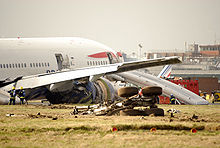 British Airways flight BA038 which crash landed just short of the runway on 17 January 2008
British Airways flight BA038 which crash landed just short of the runway on 17 January 2008
- On 5 November 1997, a Virgin Atlantic Airbus A340-300, G-VSKY, made an emergency landing following an undercarriage malfunction. Part of the undercarriage collapsed on landing, and both aircraft and runway were damaged. Recommendations made as a result of the accident included one that aircraft cabin door simulators should more accurately reproduce operating characteristics in an emergency, and another that cockpit voice recorders should have a two-hour duration in aircraft registered before April 1998.[83]
- On 17 January 2008, a British Airways Boeing 777-236ER, G-YMMM, operating flight BA038 from Beijing, crash-landed at Heathrow. The aircraft landed on grass short of the south runway, then slid to the edge of the runway and stopped on the threshold, leading to eighteen minor injuries. The aircraft was later found to have suffered loss of thrust caused by fuel icing.[84]
Terrorism and security incidents
- On 8 June 1968, James Earl Ray, the man convicted of the assassination of Martin Luther King, Jr., was captured and arrested at Heathrow Airport while attempting to leave the United Kingdom on a false Canadian passport.[85]
- On 19 May 1974, the IRA planted a series of bombs in the Terminal 1 car park. Two people were injured by the explosions.[86]
- On 26 November 1983, the Brink's-MAT robbery occurred, in which 6,800 gold bars worth nearly £26 million were taken from a vault near Heathrow. Only a fraction of the gold was ever recovered, and only two men were convicted of the crime.[87]
- On 17 April 1986, semtex explosives were found in the bag of a pregnant Irishwoman attempting to board an El Al flight. The explosives had been given to her by her Jordanian boyfriend and father of their unborn child Nizar Hindawi. The incident became known as the Hindawi Affair.[88]
- On 21 December 1988, Pan Am Flight 103 from Heathrow to New York/JFK was blown up over Lockerbie, Scotland, killing all 259 on board and 11 other people on the ground.[89]
- In 1994, over a six-day period, Heathrow was targeted three times (8, 10, and 13 March) by the IRA, who fired 12 mortars. Heathrow was a symbolic target due to its importance to the UK economy, and much disruption was caused when areas of the airport were closed over the period. The gravity of the incident was heightened by the fact that the Queen was being flown back to Heathrow by the RAF on 10 March.[90]
- In March 2002, thieves stole US$3 million that had arrived on a South African Airways flight.[91]
- In February 2003, the British Army was deployed to Heathrow, along with 1,000 police officers, in response to intelligence reports suggesting that al-Qaeda terrorists might launch surface-to-air missile attacks at British or American airliners.[92]
- On 17 May 2004, Scotland Yard's Flying Squad foiled an attempt by seven men to steal £40 million in gold bullion and a similar quantity of cash from the Swissport warehouse at Heathrow.[93]
- On 10 August 2006, the airport became the focus of changes in security protocol, following the revelation of a supposed al-Qaeda terrorist plot. New security rules were put in force immediately, causing additional but essential[citation needed] restrictions in regards to carrying liquids on board flights. This caused longer queues and wait times at security. These included the prohibition of carry-on luggage (except essential items such as travel documents and medication) and all liquids – although this rule was later relaxed to allow the carrying on board of liquid medications and baby milk, provided that they were tasted first by passengers at the security checkpoint.[94]
- On 25 February 2008, Greenpeace activists protesting against the planned third runway managed to cross the tarmac and climb on top of a British Airways Airbus A320, which had just arrived from Manchester Airport. At about 09:45 GMT the protesters unveiled a banner, saying "Climate Emergency – No Third Runway", over the aircraft's tailfin. By 11:00 GMT four arrests had been made.[95]
- On 13 March 2008, a man with a rucksack scaled the perimeter fence onto runway 27R, and ran across the grounds, resulting in his subsequent arrest. A controlled explosion of his bag took place, although nothing suspicious was found, and the Metropolitan Police later said that the incident had not been terrorism related.[96]
Other incidents
- Flights from Heathrow were suspended from midday Thursday 15 April 2010 to 22:00 Tuesday 20 April 2010 due to risk of jet engines being damaged by volcanic ash in the upper atmosphere caused by the eruption of Eyjafjallajökull in Iceland.[97]
- On 18 December 2010, 'heavy' (9 cm, according to the Heathrow Winter Resilience Enquiry [98]) snowfall caused the closure of the entire airport, causing one of the largest incidents at Heathrow of all time. 4,000 flights were cancelled over five days and 9,500 passengers spent the night at Heathrow on 18 December following the initial snowfall.[99] The problems were caused not only by snow on the runways, but also by snow and ice on the 198 parking stands which were all occupied by aircraft.[100]
Future expansion
Runway and terminal expansion
Main article: Expansion of London Heathrow AirportIn January 2009 the Transport Secretary Geoff Hoon announced that the UK government supports the expansion of Heathrow by building a third 2,200-metre (7,200 ft) runway and a sixth terminal building.[101] This decision follows the 2003 white paper on the future of air transport in the UK,[102] and a public consultation in November 2007.[103] This was a controversial decision which met with widespread opposition because of its greenhouse gas emissions, destruction of local communities, as well as noise and air pollution concerns.
Before the 2010 General Election the Conservative and Liberal Democrats parties announced that they would prevent the construction of any third runway or further material expansion of the airport's operating capacity. The Mayor of London, Boris Johnson, has admitted that London needs more airport capacity but favours constructing an entirely new airport in the Thames Estuary rather than expanding Heathrow.[104] After the Conservative – Liberal Democrat coalition took power, it was announced that the third runway expansion was cancelled.[10]
Heathrow railway hub
A plan to make Heathrow an international railway exchange has also been proposed with the potential construction of Heathrow Hub railway station,[105] built on a link to the High Speed 2 railway line.[106]
Airtrack
In July 2009, Heathrow Airport Limited submitted an application to the Secretary of State for Transport seeking to gain authorisation to develop a new rail link to Heathrow Terminal 5 to be known as Heathrow Airtrack.[107] The rail link would address the current lack of public transport available to the South West of the Airport by connecting to Guildford, Reading and London Waterloo. BAA state that the scheme should add significantly to their aim of increasing the proportion of people using public transport to travel to the Airport.[108] In April 2011, BAA announced that it was abandoning the project,[109] citing the unavailability of government subsidy and other priorities for Heathrow,[110] such as linking to Crossrail and HS2.
Heathrow/Gatwick Rail Link
The Department for Transport is currently studying the possibility of a direct, high-speed rail link between Heathrow and Gatwick Airport.[111]
See also
- List of airports in the United Kingdom
- World's busiest airports by passenger traffic
- World's busiest city airport systems by passenger traffic
- Busiest airports in Europe by passenger traffic
References
- ^ a b c "London Heathrow – EGLL". Nats-uk.ead-it.com. http://www.nats-uk.ead-it.com/public/index.php%3Foption=com_content&task=blogcategory&id=94&Itemid=143.html. Retrieved 21 April 2011.
- ^ a b "UK Airport Statistics". Civil Aviation Authority. http://www.caa.co.uk/default.aspx?catid=80&pagetype=88&pageid=3&sglid=3. Retrieved 21 April 2011.
- ^ "Year to date International Passenger Traffic November 2010". Airports Council International. 16 February 2011. Archived from the original on 10 March 2011. http://www.webcitation.org/5x5F2XC3a.
- ^ "Busiest Airports – The Busiest Airports in the World". Geography.about.com. http://geography.about.com/od/urbaneconomicgeography/a/busiestairports.htm. Retrieved 21 April 2011.
- ^ "UK airports owned and operated by BAA". BAA Limited. http://www.baa.com/. Retrieved 21 April 2011.
- ^ "Who we are". BAA Limited. http://www.baa.com/portal/page/About/BAA+Airports%5EAbout+BAA%5EWho+we+are/c44e357c07eee110VgnVCM10000036821c0a____/448c6a4c7f1b0010VgnVCM200000357e120a____/%20BAA. Retrieved 21 April 2011.
- ^ a b "Heathrow’s Terminal 2 closes as work on its £1 billion replacement gets underway". London Heathrow Airport. http://www.heathrowairport.com/portal/page/Heathrow%5EGeneral%5EOur%20business%20and%20community%5EMedia%20centre%5ENews%20releases%5EResults/72b601271e115210VgnVCM10000036821c0a____/a22889d8759a0010VgnVCM200000357e120a____/. Retrieved 23 November 2009.
- ^ "Britain: Third Heathrow runway approved despite opposition". CNN. 15 January 2009. http://www.cnn.com/2009/BUSINESS/01/15/heathrow.third.runway/index.html. Retrieved 11 May 2010.
- ^ "Go-ahead for new Heathrow runway". BBC News. 15 January 2009. http://news.bbc.co.uk/1/hi/uk_politics/7829676.stm. Retrieved 21 April 2011.
- ^ a b "Heathrow third runway plans scrapped by new government". BBC News. 12 May 2010. http://news.bbc.co.uk/1/hi/england/london/8678282.stm. Retrieved 21 April 2011.
- ^ "Licence No. P527". Civil Aviation Authority. http://www.caa.co.uk/docs/375/srg_as_publiclicencesandmaps.pdf. Retrieved 6 May 2011.
- ^ "International Air Passenger Traffic To and From Reporting Airports for 2008" (PDF). Civil Aviation Authority. http://www.caa.co.uk/docs/80/airport_data/2008Annual/Table_12_1_Intl_Air_Pax_Route_Analysis_2008.pdf. Retrieved 7 May 2011.
- ^ "Annual UK Airport Statistics: 2009 – annual". Civil Aviation Authority. http://www.caa.co.uk/default.aspx?catid=80&pagetype=88&sglid=3&fld=2009. Retrieved 21 April 2011.
- ^ "Thiefrow gang lifts £1m of duty-free". The Sun (London). 11 November 2008. http://www.thesun.co.uk/sol/homepage/news/article1915827.ece. Retrieved 29 November 2009.
- ^ "Body scanners". Heathrow Airport. http://www.heathrowairport.com/portal/page/Heathrow%5EGeneral%5EAirport%20information%5EHeathrow%20security%5ESecurity+FAQs/76bb00df152dd010VgnVCM10000036821c0a____/448c6a4c7f1b0010VgnVCM200000357e120a____/#8a. Retrieved 7 May 2011.
- ^ "Worship". Heathrow Airport. http://www.heathrowairport.com/portal/page/Heathrow%5EGeneral%5EAirport+information%5EServices+and+facilities%5EWorship/db209b25f9599110VgnVCM10000036821c0a____/448c6a4c7f1b0010VgnVCM200000357e120a____/. Retrieved 7 May 2011.
- ^ "Heathrow's hidden gems". CNN. 13 July 2007. http://www.cnn.com/2007/TRAVEL/07/13/bt.citytips/index.html. Retrieved 21 April 2011.
- ^ "Landing at Heathrow". BBC. 18 January 2008. http://news.bbc.co.uk/1/hi/uk/7196158.stm. Retrieved 20 January 2008.
- ^ BAA Heathrow (2004/05) (PDF). Flight Evaluation Report 2004/05. http://www.heathrowairport.com/assets//B2CPortal/Static%20Files/New2005Booklet.pdf. Retrieved 2 November 2007.
- ^ During periods of westerly operation, aircraft continue to fly in a westerly direction with easterly tailwinds up to 5 knots (9.3 km/h; 5.8 mph).
- ^ "Heathrow noise: Noise limits". http://www.heathrowairport.com/portal/page/Heathrow+noise%5EGeneral%5EWhat+we+do+about+it%5EMeasures+already+in+place%5ENoise+limits/e4c4ff6b59b53210VgnVCM10000036821c0a____/448c6a4c7f1b0010VgnVCM200000357e120a____/. Retrieved 7 May 2011.
- ^ "IATA attacks higher landing charges at British airports". http://afp.google.com/article/ALeqM5izyYRsZKFHEIOR6WYbdtInUOLqgA. Retrieved 14 March 2008.
- ^ "Economic Regulation of Heathrow and Gatwick Airports 2008–2013". Civil Aviation Authority. 11 March 2008. http://www.baa.com/assets/Internet/BAA%20Airports/Downloads/Static%20files/Economic_Regulation.pdf. Retrieved 7 May 2011.
- ^ "BA boss joins attack on Heathrow". BBC. 1 August 2007. http://news.bbc.co.uk/1/hi/business/6926150.stm. Retrieved 28 October 2007.
- ^ Millward, David (30 October 2007). "Heathrow voted world's least favourite airport". The Daily Telegraph (UK). http://www.telegraph.co.uk/travel/main.jhtml?xml=/travel/2007/10/30/et-airport-130.xml. Retrieved 30 October 2007.
- ^ Airport CoOrdination Ltd (February 2002) (PDF). Submission to the CAA Regarding Peak Periods at Heathrow. http://www.caa.co.uk/docs/5/ergdocs/baajan03/acl2baajan03.pdf. Retrieved 13 January 2008.
- ^ "BAA Heathrow: Mixed mode". BAA. http://www.heathrowairport.com/portal/page/General/Heathrow%5EGeneral%5EOur+business+and+community%5EFuture+growth%5EMixed+mode/1c8851dcd7423110VgnVCM10000036821c0a____/448c6a4c7f1b0010VgnVCM200000357e120a____/. Retrieved 11 November 2007.
- ^ "BA pushes for 'mixed mode' at Heathrow". UK-Airport-News.info. http://www.uk-airport-news.info/heathrow-airport-news-161206a.htm. Retrieved 31 May 2008.
- ^ Webster, Ben (7 August 2007). "Heathrow is defeated in its attempt to ban environmental campaigners". The Times (London). http://www.timesonline.co.uk/tol/news/uk/article2211142.ece. Retrieved 9 August 2007.
- ^ Above Us The Skies: The Story Of BAA – 1991 (Michael Donne – BAA plc), p. 40
- ^ Last call for Heathrow Terminal 2, BBC News. 23 November 2009.
- ^ "Demolition work begins at Heathrow's Terminal 2". BBC News. 29 April 2010. http://news.bbc.co.uk/1/hi/england/london/8650872.stm. Retrieved 30 April 2010.
- ^ "Our history". BAA Limited. http://www.heathrowairport.com/portal/page/Heathrow%5EGeneral%5EOur+business+and+community%5EHeathrow+lowdown%5EOur+history/12223de26aa32010VgnVCM100000147e120a____/448c6a4c7f1b0010VgnVCM200000357e120a____/. Retrieved 7 May 2011.
- ^ "Debut A380 flight lands in London". BBC News. 18 March 2008. http://news.bbc.co.uk/1/hi/business/7301455.stm. Retrieved 19 March 2008.
- ^ "BAA Heathrow unveils plans to re-develop Terminal 3". BAA Plc. http://www.heathrowairport.com/portal/controller/dispatcher.jsp?CiID=12d6b6c0100c0110VgnVCM10000036821c0a____&ChID=10b35109350d3110VgnVCM10000036821c0a____&Ct=B2C_CT_PRESS_RELEASE&CtID=a22889d8759a0010VgnVCM200000357e120a____&ChPath=Home%5EHeathrow%5EHeathrow+press+releases. Retrieved 1 December 2008.
- ^ [http://www.heathrowairport.com/portal/page/Heathrow%5EGeneral%5EOur%20business%20and%20community%5EMedia%20centre%5ENews%20releases%5EResults/97dd2706f959 d110VgnVCM10000036821c0a____/a22889d8759a0010VgnVCM200000357e120a____/ "Terminal 4's £100m new check-in area reaches the top"]. BAA Plc. http://www.heathrowairport.com/portal/page/Heathrow%5EGeneral%5EOur%20business%20and%20community%5EMedia%20centre%5ENews%20releases%5EResults/97dd2706f959 d110VgnVCM10000036821c0a____/a22889d8759a0010VgnVCM200000357e120a____/. Retrieved 30 November 2008.
- ^ "Queen opens new Heathrow Terminal". BBC. 14 March 2008. http://news.bbc.co.uk/1/hi/uk/7294618.stm. Retrieved 14 March 2008.
- ^ "British Airways reveals what went wrong with Terminal 5". Computer Weekly. 14 May 2008. http://www.computerweekly.com/Articles/2008/05/14/230680/british-airways-reveals-what-went-wrong-with-terminal.htm. Retrieved 17 May 2008.
- ^ "Heathrow Terminal 5". http://www.richardrogers.co.uk/Asp/uploadedFiles/Image/1065_t5/RSHP_A_JS_1065_L_E_GB.pdf.
- ^ "Heathrow Terminal 5: The Vital Statistics". Sky News. 15 March 2008. http://news.sky.com/skynews/Home/Sky-News-Archive/Article/200806413649522. Retrieved 7 May 2011.
- ^ "ULTra PRT – FAQ". ATS ULTra. 2010. http://www.ultraprt.com/prt/faq/. Retrieved 1 July 2010.
- ^ a b "Qantas and BA announce JSA revamp". Business Traveller. 16 August 2011. http://www.businesstraveller.com/news/qantas-and-ba-announce-jsa-revamp. Retrieved 16 August 2011.
- ^ . Sri Lanka Mirror. http://srilankamirror.com/english/business/39-business/4719-sri-lankan-airlines-to-start-zurich-flights.
- ^ The Vancouver Sun (Vancouver). http://www.vancouversun.com/business/Virgin+Atlantic+offer+direct+flights+between+Vancouver+London/5665015/story.html.
- ^ "Heathrow looks ahead", Airports(Key Publishing), September/October 2007, P30
- ^ "Star Alliance Airlines Move From Terminal 2 To Terminal 1 At London's Heathrow Airport". Star Alliance. 18 June 2009. http://www.staralliance.com/en/press/staralliance-lhr-move-from-terminal1-terminal2-prp. Retrieved 7 May 2011.
- ^ "Contact us." BAA Limited. Retrieved on 27 February 2010.
- ^ "BA Recruitment." British Airways. 3 March 2006. Retrieved on 2 October 2010.
- ^ "World Business Centre Heathrow." Aurora Management Services. Retrieved on 18 November 2011.
- ^ "Contact." International Airlines Group. Retrieved on 29 January 2011. "Postal address International Airlines Group 2 World Business Centre Heathrow, Newall Road, London Heathrow Airport, HOUNSLOW, TW6 2SF"
- ^ "About Us." International Airlines Group. Retrieved on 29 January 2011. "The corporate head office for IAG is in London, UK."
- ^ "World Airline Directory." Flight International. 26 March – 1 April 1997. 58. "Speedbird House, PO Box 10, London Heathrow Airport, Hounslow, Middlesex, TW6 2JA, UK."
- ^ McKellar, Susie and Penny Sparke. "The Contemporary Office." Interior Design and Identity. Manchester University Press, 2004. 200. Retrieved from Google Books on 12 February 2010. ISBN 0719067294, 9780719067297.
- ^ "BAA Heathrow Home Page". BAA. http://www.heathrowairport.com/portal/page/Heathrow%5EGeneral%5EOur+business+and+community%5EHeathrow+Lowdown%5EHeathrow+at+a+Glance/08ba07077d3d2010VgnVCM100000147e120a____/448c6a4c7f1b0010VgnVCM200000357e120a____/. Retrieved 18 February 2009.
- ^ "Paris Airport Statistics". Aeroportsdeparis.fr. http://www.aeroportsdeparis.fr/ADP/en-GB/Group/Finance/Traffic/2010/2010.htm. Retrieved 21 April 2011.
- ^ "Fraport Traffic Figures – May 2010: Impressive Growth in Passenger". Frankfurt Airport. 14 June 2010. http://www.frankfurt-airport.com/content/frankfurt_airport/en/news/fraport_traffic_figuresmay2010impressivegrowthinpassenger.html. Retrieved 7 May 2011.
- ^ "Traffic Movements 2009 Final". Airports Council International. http://www.airports.org/cda/aci_common/display/main/aci_content07_c.jsp?zn=aci&cp=1-5-54-57-9814_666_2__. Retrieved 13 March 2010.
- ^ "Cargo Traffic 2007 Final". Airports Council International. http://www.airports.org/cda/aci_common/display/main/aci_content07_c.jsp?zn=aci&cp=1-5-54-4819_666_2__. Retrieved 13 March 2010.
- ^ "UK Airport Statistics". CAA. http://www.caa.co.uk/docs/80/airport_data/2010Annual/Table_12_1_Intl_Air_Pax_Route_Analysis_2010.pdf. Retrieved 30 Aug 2011.
- ^ "Intl Pax Traffic to from UK by Country 2010". CAA. http://www.caa.co.uk/docs/80/airport_data/2010Annual/Table_11_Intl_Pax_Traffic_to_from_UK_by_Country_2000_2010.pdf. Retrieved 7 June 2011.
- ^ "Heathrow trains". Heathrow Airport. http://www.heathrowairport.com/portal/page/Heathrow%5EGeneral%5ETo+and+from+Heathrow%5ETrains/759c9b25f9599110VgnVCM10000036821c0a____/448c6a4c7f1b0010VgnVCM200000357e120a____/. Retrieved 7 May 2011.
- ^ "BAA Heathrow: Coaches". London Heathrow Airport. http://www.heathrowairport.com/portal/page/Heathrow%5EGeneral%5ETo+and+from+Heathrow%5EBuses+and+coaches%5ECoach/6c6c9e9260599110VgnVCM10000036821c0a____/448c6a4c7f1b0010VgnVCM200000357e120a____/. Retrieved 21 April 2011.
- ^ "Heathrow hotel transfers by bus". Heathrow Airport. http://www.heathrowairport.com/portal/page/Heathrow%5EGeneral%5ETo+and+from+Heathrow%5EBuses+and+coaches%5EHotel+buses/e5433de24f0d6210VgnVCM10000036821c0a____/448c6a4c7f1b0010VgnVCM200000357e120a____/. Retrieved 7 May 2011.
- ^ "BAA Heathrow: Railair". London Heathrow Airport. http://www.heathrowairport.com/portal/page/Heathrow%5EGeneral%5ETo+and+from+Heathrow%5EBuses+and+coaches%5ERailair/47942ed4f4599110VgnVCM10000036821c0a____/448c6a4c7f1b0010VgnVCM200000357e120a____/. Retrieved 21 April 2011.
- ^ "BAA Heathrow: Local buses". London Heathrow Airport. http://www.heathrowairport.com/portal/page/Heathrow%5EGeneral%5ETo+and+from+Heathrow%5EBuses+and+coaches%5ELocal+bus/010d2ed4f4599110VgnVCM10000036821c0a____/448c6a4c7f1b0010VgnVCM200000357e120a____/. Retrieved 21 April 2011.
- ^ "BAA Heathrow: Travel between terminals – Heathrow terminal transfers". http://www.heathrowairport.com/portal/page/Heathrow^General^Airport+information^Travel+between+terminals/aedd3db5569a9110VgnVCM10000036821c0a____/448c6a4c7f1b0010VgnVCM200000357e120a____/.
- ^ "Heathrow Airport Buses – Free Bus Routes". http://www.milesfaster.co.uk/information/heathrow-airport/heathrow-london-bus.htm.
- ^ "Heathrow to Debut Futuristic Travel Pods". PopSci.com.au. 27 January 2009. http://www.popsci.com.au/scitech/article/2009-01/heathrow-debut-futuristic-travel-pods. Retrieved 27 January 2009.
- ^ "Taxis, minicabs and chauffeurs". Heathrow Airport. http://www.heathrowairport.com/portal/page/Heathrow%5EGeneral%5ETo+and+from+Heathrow%5ETaxis/26f89b25f9599110VgnVCM10000036821c0a____/448c6a4c7f1b0010VgnVCM200000357e120a____/. Retrieved 7 May 2011.
- ^ "BAA Heathrow: Heathrow short stay parking". London Heathrow Airport. http://www.heathrowairport.com/portal/page/Heathrow%5EGeneral%5ETo+and+from+Heathrow%5EHeathrow+parking+options%5EHeathrow+short+stay+parking/0e46c6eff2e62010VgnVCM100000147e120a____/448c6a4c7f1b0010VgnVCM200000357e120a____/. Retrieved 6 May 2011.
- ^ "BAA Heathrow: Heathrow long stay parking". London Heathrow Airport. http://www.heathrowairport.com/portal/page/Heathrow%5EGeneral%5ETo+and+from+Heathrow%5EHeathrow+parking+options%5EHeathrow+long+stay+parking/d88873e3b8d62010VgnVCM100000147e120a____/448c6a4c7f1b0010VgnVCM200000357e120a____/. Retrieved 6 May 2011.
- ^ Transport for London free maps 'London Cycling Guide 6' covers Terminals 1, 2 & 3 while 'London Cycling Guide 9' covers Terminal 4 (as of the June 2007 revision).
- ^ Cycling and Motorcycling map.
- ^ "On This Day The Times 3 March 1948". The Times (London). 3 March 2003. http://www.timesonline.co.uk/printFriendly/0,,1-46-597343,00.html. Retrieved 11 May 2010.[dead link]
- ^ "Aviation Safety Network G-AHPN". Aviation-safety.net. http://aviation-safety.net/database/record.php?id=19501031-0. Retrieved 21 April 2011.
- ^ Blackman, Tony. Vulcan Test Pilot: My Experiences in the Cockpit of a Cold War Icon. London: Grub Street, 2007. ISBN 9781904943884. p. 142
- ^ "Accident description". Aviation Safety Network. http://aviation-safety.net/database/record.php?id=19600107-0. Retrieved 14 September 2009.
- ^ "ASN Aircraft accident description Vickers 951 Vanguard G-APEE – London-Heathrow Airport (LHR)". Aviation Safety Network. http://aviation-safety.net/database/record.php?id=19651027-0&lang=en. Retrieved 21 April 2011.
- ^ "Women awarded the George Cross". Stephen-stratford.co.uk. http://www.stephen-stratford.co.uk/women_gcs.htm. Retrieved 21 April 2011.
- ^ "Aviation Safety Network G-AMAD". Aviation Safety Network. http://aviation-safety.net/database/record.php?id=19680703-0. Retrieved 21 April 2011.
- ^ "Accident description". Aviation Safety Network. http://aviation-safety.net/database/record.php?id=19700122-0. Retrieved 8 October 2009.
- ^ "1972: UK's worst air crash kills 118". BBC News. 18 June 1972. http://news.bbc.co.uk/onthisday/hi/dates/stories/june/18/newsid_2515000/2515787.stm. Retrieved 7 May 2011.
- ^ Symonds, Tom (3 August 2000). "Pilots praised for crash landing". BBC News. http://news.bbc.co.uk/1/hi/uk/864184.stm. Retrieved 7 May 2011.
- ^ Symonds, Tom (4 September 2008). "'Ice in fuel' caused BA jet crash". BBC News. http://news.bbc.co.uk/1/hi/england/london/7598267.stm. Retrieved 7 May 2011.
- ^ Borrell, Clive (28 June 1968). "Ramon Sneyd denies that he killed Dr King". The Times (London): p. 2. http://archive.timesonline.co.uk/tol/viewArticle.arc?articleId=ARCHIVE-The_Times-1968-06-28-02-006&pageId=ARCHIVE-The_Times-1968-06-28-02. Retrieved 13 January 2009.
- ^ "Heathrow Airport History". Milesfaster.co.uk. http://www.milesfaster.co.uk/information/heathrow-airport/heathrow-history.htm. Retrieved 31 May 2008.
- ^ "Brinks Mat gold". BBC News. 15 April 2000. http://news.bbc.co.uk/1/hi/uk/714289.stm. Retrieved 31 May 2008.
- ^ Reynolds, Paul (16 December 2002). "Assad engages politics of politeness". BBC News. http://news.bbc.co.uk/1/hi/world/middle_east/2581277.stm. Retrieved 31 May 2008.
- ^ "1988: Jumbo jet crashes onto Lockerbie". BBC News. 21 December 1988. http://news.bbc.co.uk/onthisday/hi/dates/stories/december/21/newsid_2539000/2539447.stm. Retrieved 7 May 2011.
- ^ Henderson, Scott (1998). Silent Swift Superb: The Story of the Vickers VC10. Newcastle-upon-Tyne: Scoval. p. 130. ISBN 1-901125-02-5.
- ^ "$3m heist at Heathrow". BBC News. 19 March 2002. http://news.bbc.co.uk/1/hi/england/1880953.stm. Retrieved 31 May 2008.
- ^ Archive copy at the Wayback Machine
- ^ "Flying Squad foils £80m robbery". BBC News. 18 May 2004. http://news.bbc.co.uk/2/hi/uk_news/3723839.stm. Retrieved 7 May 2011.
- ^ Batty, David; Oliver, Mark (10 August 2006). "'Mass murder terror plot' uncovered". The Guardian (UK). http://www.guardian.co.uk/world/2006/aug/10/terrorism.politics. Retrieved 6 May 2011.
- ^ "Climate protest on Heathrow plane". BBC News. 25 February 2008. http://news.bbc.co.uk/1/hi/uk/7262614.stm. Retrieved 31 May 2008.
- ^ "Man arrested over Heathrow alert". BBC News. 13 March 2008. http://news.bbc.co.uk/1/hi/england/london/7294745.stm. Retrieved 31 May 2008.
- ^ "Icelandic volcanic ash alert grounds UK flights". BBC News. 15 April 2010. http://news.bbc.co.uk/1/hi/uk/8621407.stm. Retrieved 21 April 2011.
- ^ "Heathrow Winter Resilience Enquiry". http://www.baa.com/assets/Internet/BAA%20Airports/Downloads/Static%20files/BeggReport220311_BAA.pdf.
- ^ "BAA launches inquiry into Heathrow Airport snow chaos". BBC News. 23 December 2010. http://www.bbc.co.uk/news/uk-england-london-12071442. Retrieved 6 May 2011.
- ^ "De-icing Aircraft Parking Stands". http://www.icax.co.uk/Deicing_Runways.html.
- ^ "Britain’s Transport Infrastructure: Adding Capacity at Heathrow: Decisions Following Consultation, January 2009". Department of Transport. http://webarchive.nationalarchives.gov.uk/+/http://www.dft.gov.uk/pgr/aviation/heathrowconsultations/heathrowdecision/decisiondocument/decisiondoc.pdf. Retrieved 16 January 2009.
- ^ "The Future of Air Transport" (PDF). 1 December 2003. http://www.dft.gov.uk/about/strategy/whitepapers/air/thefutureofairtransportwhite5694.
- ^ "Industry backs third Heathrow runway as consultation opens". Flight International. 22 November 2007. http://www.flightglobal.com/articles/2007/11/22/219826/industry-backs-third-heathrow-runway-as-consultation-opens.html. Retrieved 8 December 2007.
- ^ "Heathrow's new runway". BBC News. 15 January 2009. http://news.bbc.co.uk/1/hi/uk_politics/7722261.stm. Retrieved 21 April 2011.
- ^ Oakeshott, Isabel; Gourlay, Chris (4 January 2009). "Heathrow train plan to allay environmental fears". The Times (London). http://www.timesonline.co.uk/tol/news/politics/article5439472.ece. Retrieved 11 May 2010.
- ^ "High Speed Rail: Investing in Britain's Future". Department for Transport. http://www.dft.gov.uk/pgr/rail/pi/highspeedrail/. Retrieved 7 May 2011.
- ^ "Heathrow Airtrack". BAA. http://www.baa.com/portal/controller/dispatcher.jsp?CiID=100046e4daa55110VgnVCM10000036821c0a____&ChID=0f1aabefebb55110VgnVCM10000036821c0a____&Ct=B2C_CT_GENERAL&CtID=448c6a4c7f1b0010VgnVCM200000357e120a____&ChPath=Home^Heathrow^General^Our+business+and+community^Heathrow+transformation^Heathrow+Airtrack. Retrieved 21 April 2011.
- ^ "The Need For Heathrow Airtrack". BAA Limited. http://www.baa.com/assets/Internet/Heathrow/Heathrow%20downloads/Static%20files/Airtrack_Statement_of_Aims_D0049.pdf. Retrieved 7 May 2011.
- ^ "Heathrow Airtrack Waterloo rail link shelved by BAA". BBC News London. 11 April 2011. http://www.bbc.co.uk/news/uk-england-london-13042740. Retrieved 11 April 2011.
- ^ Samuel, A. (11 April 2011). "Heathrow: 'No option but to withdraw proposed Airtrack link to Staines'". Rail News from Rail.co. http://www.rail.co/2011/04/11/heathrow-no-option-but-to-withdraw-proposed-airtrack-link-to-staines/. Retrieved 11 April 2011.
- ^ http://www.bbc.co.uk/news/uk-england-london-15227879
- Bibliography
- Cotton, Jonathan; Mills, John & Clegg, Gillian. (1986) Archaeology in West Middlesex. Uxbridge: London Borough of Hillingdon ISBN 0907869076
- Gallop, Alan. (2005) Time Flies: Heathrow At 60. Stroud: Sutton Publishing ISBN 0-7509-3840-4
- Halpenny, Bruce B. (1992) Action Stations Vol.8: Military Airfields of Greater London. ISBN 1-85260-431-X
- Sherwood, Philip. (1990) The History of Heathrow. Uxbridge: London Borough of Hillingdon ISBN 0907869270
- Sherwood, Philip. (1999) Heathrow: 2000 Years of History. Stroud: Sutton Publishing ISBN 0750921323
- Sherwood, Philip. (2006) Around Heathrow Past & Present. Sutton Publishing ISBN 0750941359
- Sherwood, Philip. (2009) Heathrow: 2000 Years of History. Stroud: The History Press ISBN 978-0752450862
- Sherwood, Tim. (1999) Coming in to Land: A Short History of Hounslow, Hanworth and Heston Aerodromes 1911–1946. Heritage Publications (Hounslow Library) ISBN 1-899144-30-7
- Smith, Graham. (2003) Taking to the Skies: the Story of British Aviation 1903–1939. Countryside ISBN 1853068152
- Smith, Ron. (2002) British Built Aircraft Vol.1. Greater London: Tempus ISBN 0-7524-2770-9
- Sturtivant, Ray. (1995) Fairey Aircraft: in Old Photographs. Alan Sutton ISBN 0750911352
- Taylor, H.A. (1974) Fairey Aircraft since 1915. Putnam ISBN 0-370-00065-X.
- Taylor, John WR. (1997) Fairey Aviation: Archive Photographs. Chalford ISBN 0752406841
External links
- Official website
- Heathrow Airport Consultative Committee
- Heathrow Airport travel guide from Wikitravel
- The building of Heathrow Video at the Internet Archive
- Heathrow Air Watch – Information on pollution levels around Heathrow
- Heathrow airport's resident TV crew – official website
- Longford Residents' Association (thisislongford.com) archived copy
 Airports in the United Kingdom and the Crown Dependencies
Airports in the United Kingdom and the Crown DependenciesEngland Birmingham · Blackpool · Bournemouth · Bristol · Doncaster-Sheffield · Durham Tees Valley · East Midlands · Exeter · Humberside · Leeds-Bradford · Liverpool · London City · London-Gatwick · London Heathrow · London Luton · London Southend · London Stansted · Manchester · Newcastle · Newquay · Norwich · Plymouth · Southampton
Biggin Hill • Cambridge • Gloucestershire • Kent • Land's End • Oxford • Lydd • Penzance • St Mary's • TrescoScotland Aberdeen · Edinburgh · Glasgow International · Glasgow Prestwick · Inverness
Barra • Benbecula • Campbeltown • Dundee • Eday • Fair Isle • Islay • Kirkwall • Lerwick • North Ronaldsay • Oban • Papa Westray • Sanday • Scatsta • Stornoway • Stronsay • Sumburgh • Tiree • Westray • WickWales Northern Ireland Crown Dependencies Alderney · Guernsey · Isle of Man · Jersey
Smaller font-size indicates airports handling domestic, charter or private services only.Terminals Terminal 1 · Terminal 2 (under construction) · Terminal 3 · Terminal 4 · Terminal 5
Air hub for Rail Stations Rail Services Future Crossrail · Heathrow Airtrack (abandoned) · Heathrow Hub station · Terminal 2 · Terminal 6 & Runway 3Tunnels Public London Heathrow Airport · Gatwick Airport · London Stansted Airport · London Luton Airport · London City Airport · London Southend AirportMilitary Private Categories:- Airports in the London region
- Airports established in 1929
- BAA Limited
- Buildings and structures in Hillingdon
- London Heathrow Airport
- M4 corridor
- Proposed airport expansion
- Public inquiries in the United Kingdom
- Transport in Hillingdon
- Transport projects in London
- Visitor attractions in Hillingdon
Wikimedia Foundation. 2010.

